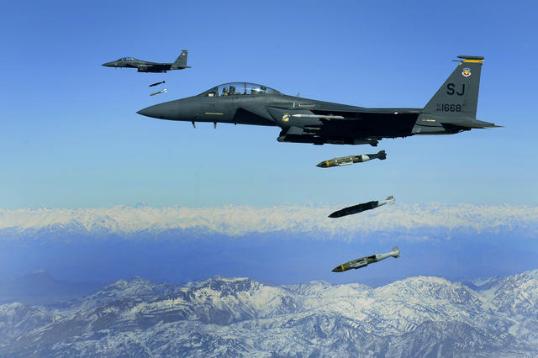|
|
|
IUS Air Force F-15E Strike Eagle aircraft from the 335th Expeditionary Fighter Squadron drop 2,000-pound Joint Direct Attack Munitions on a cave in eastern Afghanistan on Nov. 26, 2009. The 335th is deployed to Bagram Air Field, Afghanistan. US Air Force photo by Staff Sergeant Michael B. Keller. |
Taliban commander among 20 killed in US airstrike in eastern Afghanistan
A regional Taliban commander and dozens of his followers were killed in a US airstrike in the eastern Afghan province of Kunar.
US strike aircraft hit a Taliban complex in the village of Tsangar Darah in the contested district of watahpur, killing Taliban commander Noor Akbar and dozens of his followers.
“More than 20 Taliban fighters, including their commander Noor Akbar, were killed in the raid,” Afghan army General Mohammad Qasim told AFP. According to Pajhwok Afghan News, 36 Taliban fighters were killed in the airstrike. US officials did not provide enemy casualty estimates.
The International Security Assistance Force confirmed the strike and said the target was “a known Taliban stronghold consisting of bunkers and prepared defensive positions in Kunar province.”
“The security force targeted the stronghold near the village of Tsangar Darah in the mountainous watahpur district after intelligence sources indicated militant activity at the location,” ISAF said in a press release.
Today’s attack in Kunar follows a raid by US Special Forces and Afghan commandos on Dec. 2 that killed Taliban commanders Maulvi Maseehullah and Tawab, two Taliban fighters, and two al Qaeda operatives in the village of Sangar, also in the watahpur district. Al Qaeda embeds members of its Shadow Army, or the Lashkar al Zil, with Taliban units to provide expertise and training.
Both Kunar and neighboring Nuristan province have been Taliban and al Qaeda hotbeds. These remote, mountainous provinces border Pakistan’s northern tribal areas and are a main transit route for Taliban fighters operating in Bajaur, Dir, and Chitral. Much of Kunar and Nuristan is either contested or under Taliban control.
After the Taliban almost overran combat outposts in Wanat in 2008 and Kamdish in 2009, the ISAF withdrew from some of the remote bases in Nuristan and Kunar. The withdrawal began just four days after Combat Outpost Keating in Kamdish was nearly overrun. The military said the withdrawal was part of a refocusing of efforts to provide security in population centers.
“Despite Taliban claims, the movement of troops and equipment from the outposts are a part of a previously scheduled transfer,” the military continued. “The remote outposts were established as part of a previous security strategy to stop or prevent the flow of militants into the region.”
The Taliban took advantage of the withdrawal and openly began to administer the areas uncontested. The Taliban reaped a propaganda windfall by releasing video of Taliban fighters occupying Keating.
The Taliban and al Qaeda also said the abandonment of outposts in the area has freed resources to conduct attacks in Pakistan and in other areas in Afghanistan.
The withdrawal of ISAF forces will force the military to increasingly rely on airstrikes and special operations raids, a US military official told The Long War Journal.
“Kunar and Nuristan have become magnets in the northeast and we’re eventually going to have to deal with that problem,” the official said.
While “surge” forces of more than 30,000 US and 7,000 European forces will largely focus on the Afghan South and East, Nuristan and Kunar “will be dealt with accordingly,” he continued.









6 Comments
We msut have spotters who painat the tragets but who confirms who ahd how many are killed. The talban are quick to admit who is killed and generally downplay the damage.
The NATO ISAF website looks like Petraeus has been doing some work on it. Winning the information war is important.
Bill Dames,
That’s been one of my concerns as well. As I understand it we rely on air surveillance of funerals and bodies collected nearby, radio intercepts and perhaps some humint from villagers. But how reliable is that information in the end?
The duplicity of the locals cannot be ignored.
Did everybody here miss the story on Yahoo a few weeks ago where the CIA admitted it was paying the ISI for intel, was cooperating with them, and almost half of the ISI budget is now provided by the CIA?
Those predators aren’t flown from spy-infested local airports, they are flown by endless shifts of pilots stateside, many directed by the CIA. No logistics train for those operators, no mission intel security problems, and rewards for HumInt aplenty. Pretty well thought out imho.
The Thunder Run has linked to this post in the blog post From the Front: 12/08/2009 News and Personal dispatches from the front and the home front.
I can only say that we need more intell in both country’s.
Special groups inserted in the public. Religious leaders should also step up to the plate and help UN officials with speaking to religious radicals. With out the support of the civilians, Efforts will be futile.